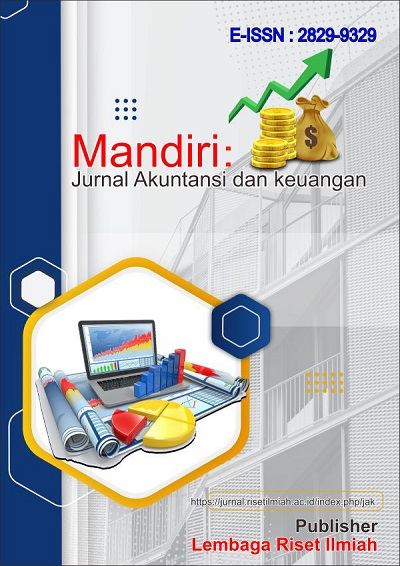Peran Komunikasi Internal Dalam Menumbuhkan Loyalitas Karyawan di UMKM Brudel Ummu Azzam Kabupaten Gorontalo
DOI:
https://doi.org/10.59086/jam.v4i3.1073Keywords:
Organizational culture, internal communication, employee loyalty, MSMEsAbstract
Internal communication is very important as a determining factor of employee loyalty in Micro, Small, and Medium Enterprises (MSMEs), especially in areas with strong social cultures but informal organizational communication systems. The purpose of this study is to evaluate how internal communication functions to increase employee loyalty at Brudel Ummu Azzam MSMEs in Gorontalo Regency. A descriptive qualitative method was used, and four informants were selected purposively through observation, documentation, and in-depth interviews. The results of the study indicate that the elements of openness and clarity of information have the greatest influence on the formation of loyalty, as both create a sense of trust and emotional involvement between management and employees. In the communication model that takes place, there is a semi-symmetrical tendency, which means that communication occurs but is not entirely equal. These results expand the application of Grunig's symmetrical two-way communication theory in the context of MSMEs and emphasize that internal communication serves as a bridge between organizational culture and employee loyalty. Simply put, this study suggests several ways to build an open and sustainable organizational culture: improving regular communication forums, providing interpersonal communication training, and using a simple digital feedback system
Downloads
References
Alrowwad, A., Abualoush, S. H., Masa’deh, R., & Al-Khayyal, A. (2021). High performance work systems and creativity: The mediating role of employee engagement. Human Resource Management International Digest, 29(7), 47–49. https://doi.org/10.1108/HRMID-06-2021-0147
Amabile, T. M., & Kramer, S. J. (2018). The progress principle: Using small wins to ignite joy, engagement, and creativity at work. Harvard Business Review Press.
Arikunto, S. (2019). Prosedur Penelitian. Rineka Cipta.
Dermol, V., & Trunk Širca, N. (2018). Communication, company mission, organizational values, and company performance. Organizacija, 51(2), 116–126. https://doi.org/10.2478/orga-2018-0009
Effendy, O. U. (2003). Ilmu Komunikasi: Teori dan Praktek. Remaja Rosdakarya.
Gostick, A., & Elton, C. (2020). Leading with gratitude: Eight leadership practices for extraordinary business results. Harper Business.
Gruber, M., & MacMillan, I. C. (2019). Where to play: 3 steps for discovering your most valuable market opportunities. Pearson Education.
Hadi, S. (2020a). Komunikasi Organisasi dalam UMKM: Antara Keterbatasan dan Strategi. Jurnal Komunikasi Dan Inovasi Bisnis, 4(2), 99–108.
Kovaitė, K., Stankevičienė, J., & Šimkonis, S. (2020). Internal communication in organizations: Importance and improvement. Administrative Sciences, 10(4), 1–15. https://doi.org/10.3390/admsci10040079
Men, L. R., & Bowen, S. A. (2017). Excellence in internal communication management. Business Expert Press. https://doi.org/10.4324/9781315206932
Meske, C., et al. (2020b). Internal Communication and Employee Engagement: The Role of Emotions in Enterprise Social Media. Journal of Enterprise Information Management.
Pace, R. W., & Faules, D. F. (2018). Komunikasi Organisasi: Strategi Meningkatkan Kinerja Organisasi. Remaja Rosdakarya.
Putra, W. D., & Darmawan, D. (2015). Peran Komunikasi Internal dan Eksternal dalam Meningkatkan Citra Organisasi. Jurnal Ilmu Komunikasi.
Rao, M. S., & Bhatnagar, J. (2022). Transformational leadership and employee engagement in SMEs: The mediating role of organizational commitment. Journal of Small Business and Enterprise Development, 29(3), 512–528. https://doi.org/10.1108/JSBED-05-2021-0195
Sugiyono. (2018). Metode Penelitian Kuantitatif, Kualitatif, dan R&D. Alfabeta.
Downloads
Published
How to Cite
Issue
Section
License
Copyright (c) 2025 Maman Musa, Sri Hadjatu

This work is licensed under a Creative Commons Attribution 4.0 International License.
This is an open-access journal. All works are published under the Creative Commons license CC-BY which means that all content is freely available at no charge to the user or his/her Institution. Users are allowed to read, download, copy, write, improve, and create derivative creation even for other lawful purposes, this license permits anyone to, as long as they cite and license the derivative creation under similar terms

This work is licensed under a Creative Commons Attribution 4.0 International License.


















